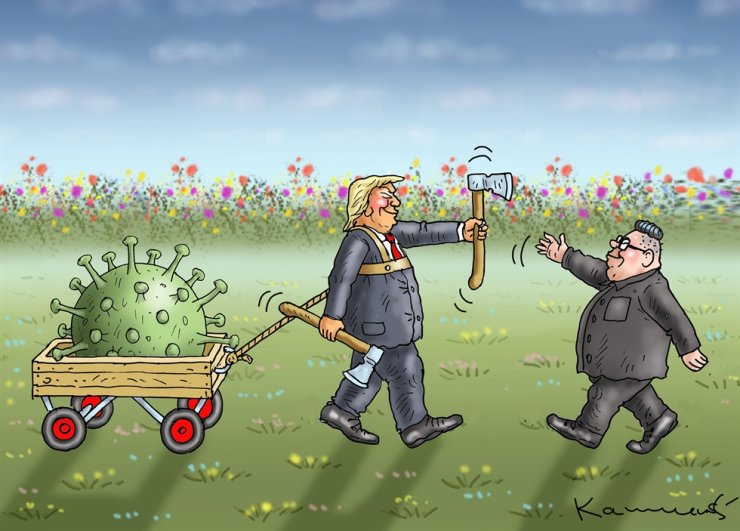COVID-19 Holds Up Mirror to Nuclear Risks
It does not seem like the right time to talk about nuclear risks and their mitigation. Attention across countries is focused on grappling with COVID-19, which has changed our perspective on life and social relations. The virus has been a great leveler ― all are experiencing an equal sense of vulnerability as the pandemic spreads uninhibited.
But, as we confront this challenge, this is, perhaps, the right time to understand the gravity of a humanitarian disaster that nations would face in circumstances in which nuclear weapons might be involved. Such a situation is not unthinkable given that nuclear risks have been steadily growing over the last few years and major nuclear powers appear loathe to even discuss, let alone address them.
As it stands, no nuclear weapon possessor is ready to give up its nuclear weapons. Rather, the role of the weapons seems to be expanding beyond the sole purpose of nuclear deterrence. Countries like North Korea and Pakistan have even shown the multi-utility of these weapons as “strategic equalizers” to superior conventional forces or bargaining chips for economic aid.
The U.S. too has expanded the role of such weapons to include deterrence of large scale conventional, cyber or space threats. Such examples add value to the nuclear weapons and reduce the chances of making non-proliferation sustainable.
Besides a growing reliance on nuclear weapons, other evident contemporary trends include the modernization of nuclear capabilities; a fast crumbling nuclear arms control architecture; and the unrestrained emergence of new technologies that could impact nuclear use.
The last issue is serious. The advancing capabilities of cyberattacks on nuclear command and control, the blurring of lines between conventional and nuclear delivery, the introduction of hypersonic missiles capable of high speed and maneuverability, and the incorporation of artificial intelligence and machine learning in nuclear decision-making will impact nuclear deterrence in ways that are not adequately understood yet.
The supposed purpose of these capabilities is to enhance nuclear deterrence by complicating the adversary’s decision to use nuclear weapons by signaling the assuredness of a response. The downside of these technologies, however, is that they could heighten misperceptions and miscalculations besides triggering an offense-defense spiral.
Ideally, every nuclear dyad must seek strategic stability to minimize such risks. This may be sought through the development of similar or superior deterrent capability or by concluding mutual restraint.
Unfortunately, nuclear states today seem inclined towards the first kind of response. There does not appear to be a common understanding of the risks being generated, nor a willingness to control technological advances that may create new security dilemmas.
A further challenge is posed by the problem that several of these dyads elongate into nuclear chains such as U.S.-Russia-China; U.S.-China-North Korea; U.S.-China-India-Pakistan. Obviously, changes in nuclear capabilities, doctrines or postures in any one actor/dyad impacts others.
Any inadvertent use of nuclear weapons in any of the dyads or chains would have severe global consequences. Of course, the severity of the damage would depend on the number and yield of weapons used.
But, studies indicate that the use of even a fraction of the arsenal held by two medium-sized countries would have repercussions beyond the immediate region of nuclear exchange for food and water availability, agricultural output, climate change, migration, etc.
Like the current pandemic, nuclear use too will be a leveler. Therefore, for the sake of international security and global stability, measures that reduce chances of inadvertent nuclear use are urgent and imperative.
Acceptance of no first use (NFU) by all nuclear armed states could be one significant step in this direction. If every country was to commit not to be the first to use the weapon, there would be no nuclear use. Such commitments would be especially helpful during times of crisis. This has been the experience, for instance, of India and China. Even during military hostilities between the two, a sense of nuclear stability has prevailed.
Universal acceptance of NFU would lead to a drop in the stock value of nuclear weapons. It would, gradually, become meaningless to retain or acquire weapons of diminishing utility. This would encourage horizontal and vertical non-proliferation. And, also create conditions for their eventual elimination.
The fight with the novel coronavirus has shown up the dismal state of public healthcare in most countries. Meanwhile, liberal spending on military preparedness continues. Is it not time to reorder national spending priorities to cater for human security as part of national security?
A useful start could be made by collectively addressing nuclear risks and eschewing foolish arms races, particularly of the nuclear kind. A global NFU could be a good confidence building measure to alter the cycle of negatives that currently pervades international relations.
COVID-19 has held up the mirror in which nuclear risks are starkly reflected. Let’s not miss the chance to see them for what they are. The cost their use might extract ― in human lives, socioeconomic upheaval, and environmental dimensions ― might be unaffordable.
Dr. Manpreet Sethi is distinguished fellow at Centre for Air Power Studies, New Delhi, leading its program on nuclear security for the last 16 years. She is author/co-author/editor of eight books and over 90 academic papers. Her book “Nuclear Strategy: India’s March towards Credible Deterrence” (2009) is deemed essential reading at many war colleges. She is recipient of the prestigious K. Subrahmanyam Award, an honor conferred by the IDSA on a scholar for excellence in strategic and security studies. She is a member of the Asia-Pacific Leadership Network for Nuclear Non-Proliferation and Disarmament (APLN). Her article was published in cooperation with the APLN.
This article was first published in The Korea Times on 1 April 2020 and is part of dedicated, regular column with analysis by APLN members on global issues. You can access the original post here.
Image: Unsplash stock, Mika Baumeister.




